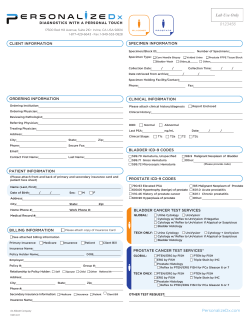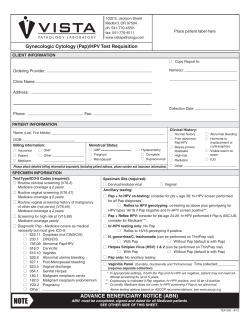
T A C
THE AFFORDABLE CARE ACT NEW MEDICARE BENEFITS Federal health care reform includes several provisions designed to help older Americans get easier access to preventative care, primary care services, and prescription medications. Following is a brief summary of these new benefits and resources for further information and help. Medicare Prescription Drug Coverage: The Affordable Care Act (ACA) provides for subsidies for out-of-pocket expenses for generic and name-brand prescription drugs for Medicare Part D enrollees. Benefits are phased in as follows: 2010: Part D enrollees whose spending reached the coverage gap received a $250 rebate. 2011: Part D enrollees whose spending reaches the coverage gap should receive a 50% discount from pharmaceutical manufacturers on name-brand drugs and biologics (vaccines and other therapeutic products created through biological processes, not chemical ones) covered through Part D. Subsidies on coinsurance for generic drug prescriptions filled in the coverage gap begin to be phased in (by 2020, Part D enrollees should only need to pay 25% of the cost of generics out-of-pocket). 2013: Federal subsidies on coinsurance for brand-name drug prescriptions filled in the coverage gap begin to be phased in (by 2020, Part D enrollees should only pay 25% of the cost of name-brand drugs out-of-pocket, after accounting for the 50% discount and coinsurance). Wellness Visits: The ACA contains several provisions meant to encourage preventative care for Medicare enrollees. Individuals can go to http://www.MyMedicare.gov and talk to their doctor (or other health care) provider to determine what services they might be eligible for. New Medicare enrollees can receive a free one-time “Welcome to Medicare” checkup within the first 12 months of program enrollment. New Medicare Benefits Fact Sheet Page 1 Starting in 2011, Medicare Part B enrollees who have been part of the program for longer than 12 months are eligible for a free yearly wellness checkup intended to help identify and manage potential health problems. Starting in 2011, cost-sharing for various preventative services recommended by the U.S. Preventative Services Task Force is eliminated. As a result, Medicare enrollees may be eligible to receive the following services for free: cardiovascular screening, breast cancer screening, cervical and vaginal cancer screening, colorectal cancer screening, prostate cancer screening, vaccinations (influenza, pneumococcal, Hepatitis B), bone mass measurements, diabetes screening, medical nutrition therapy, glaucoma tests, tobacco use cessation counseling, and HIV screening. Individuals should talk to their doctor at their wellness checkup to determine whether they should receive any of these additional preventative services. Incentives for Doctors to Care for Medicare Enrollees: The ACA also contains several provisions designed to increase the number of doctors accepting Medicare patients. 2011-2015: Providers of primary care services and general surgeons practicing in areas with health care professional shortages receive a 10% Medicare bonus. Issues to Watch Out For: The Medicare program was excluded from immediate cuts under the federal debt ceiling agreement in August 2011. However, a new Congressional committee is being created to find over $1 billion additional spending cuts. This committee could propose major cuts or changes to Medicare (as well as Medicaid and other safety net programs). If the committee fails to propose sufficient cuts, it could trigger automatic, across-the-board cuts to federal spending. This could include up to 2% cuts to Medicare provider payments, which could affect access to care for beneficiaries. Following are some of the proposals identified by the Center for Medicare Advocacy as likely to be brought up again: Raising the Age of Eligibility From 65 to 67; Combining Part A and B Deductibles Into a Single Annual Deductible – Different proposals sought to create a deductible between $550 and $560, impose 20% costsharing on all Medicare services (including Part A services that currently require either no cost-sharing, or a set co-pay), coupled with a total annual out-of-pocket cap of between $5,250 and $7,500; New Medicare Benefits Fact Sheet Page 2 Additional Means Testing of Medicare – Currently, higher income beneficiaries pay a larger share of their Part B and Part D premiums; one proposal sought to increase Part B premiums from 25% to 35% of program costs for those not already paying incomerelated premiums; Eliminating First-Dollar Medigap Coverage – This proposal prohibits Medigap plans covering the first $500 of cost-sharing and limits coverage to 50% of the next $5,000 (might include policies already held by individuals); Shifting Coverage of Persons Dually Eligible for Medicare and Medicaid (Dual eligibles) to Medicaid – This proposal gives Medicaid full responsibility for providing health coverage for persons dually eligible for Medicare and Medicaid, and requires Medicaid plans to place dual eligibles in Medicaid managed care plans. Resources for Further Information: For Individuals Seeking Information or Assistance With Their Benefits: Statewide Senior Action’s Patients Rights Helpline, including information on accessing services and benefits: call 800-333-4374 or got to www.nysenior.org. The Medicare Rights Center’s helpline: 800-333-4114. For Additional Information on the Provisions of the Law: Kaiser Family Foundation, Implementation Timeline, http://healthreform.kff.org/timeline.aspx. CMS, Your Guide to Medicare’s Preventative Services, http://www.medicare.gov/Publications/Pubs/pdf/10110.pdf. Kaiser Family Foundation, Summary of Key Changes to Medicare in 2010 Health Reform Law, http://www.kff.org/healthreform/upload/7948-02.pdf. Kaiser Family Foundation, Explaining Health Care Reform: Key Changes to Medicare Part D Drug Benefit Coverage Gap, http://www.kff.org/healthreform/upload/8059.pdf. If you would like to know more about what kind of coverage you or a member of your family is eligible for, or if you believe you are eligible for benefits you are not receiving, the Medicare Rights Center (http://www.medicarerights.org/) has developed an online database of Medicare information that may help: http://www.medicareinteractive.org/. New Medicare Benefits Fact Sheet Page 3
© Copyright 2025





















